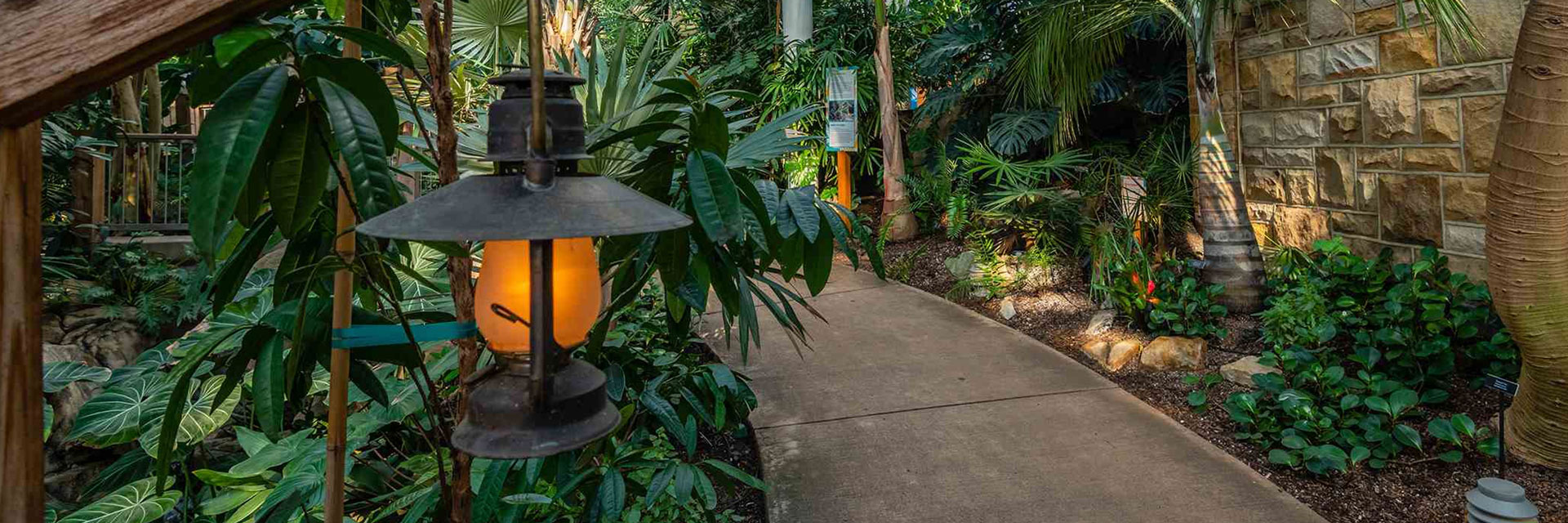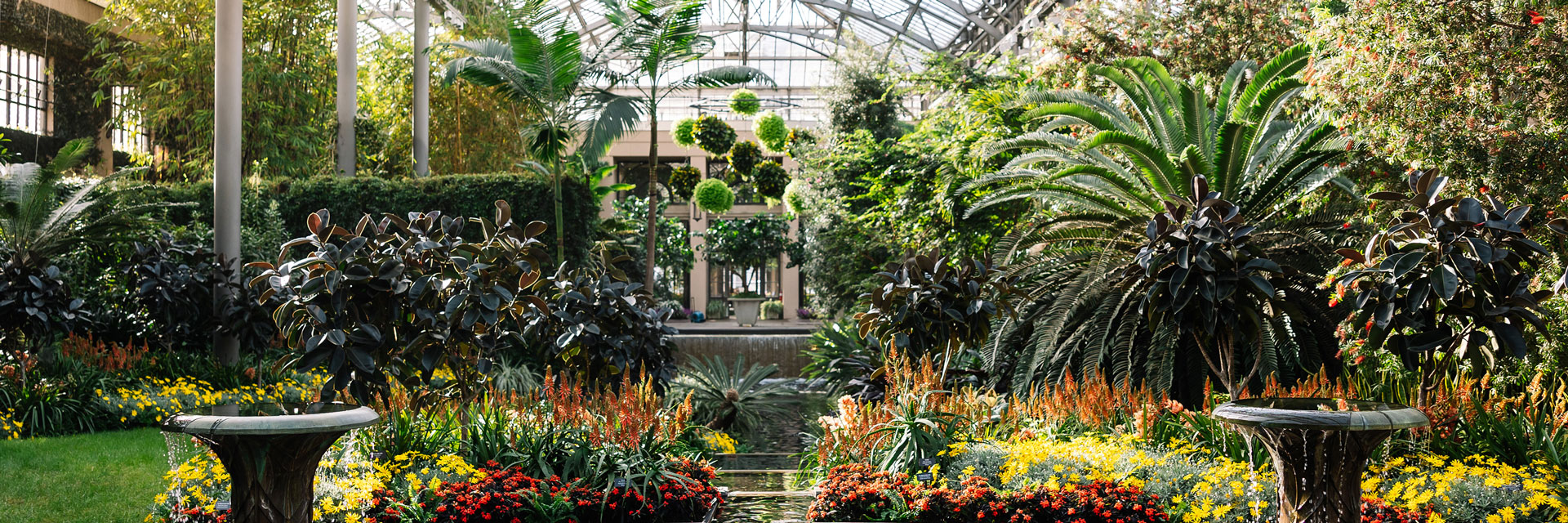Pennsylvania’s gardens are warmly welcoming all year long –providing especially cozy respites of lush greenery when the weather turns cold.
A trip to the islands, where the sun is warm and the breezes are balmy, is the perfect antidote to winter in the northeast. But you don’t have to go that far to get relief from the cold: You can spend a day surrounded by lush tropical plants, many of them in full, fragrant bloom, inside cozy glasshouses in Pittsburgh, Hershey, and Chester County. While not exactly Caribbean beaches, these enticing destinations offer a brief oasis, leaving you refreshed and ready to face the bitter temperatures again.
Here’s a travel guide, including noteworthy plants and special events, for your tropical staycation.

Phipps Convervatory and Bontanical Gardens
Pittsburgh
The glasshouse has been the centerpiece of Phipps since it opened to the public in 1893. Today, the 14-room structure is filled with thousands of tropical plants, including exceptionally rare specimens and endangered species. One star of the collection is the notorious “corpse” flower — it blooms so infrequently and briefly that when it last opened a blossom in 2013 thousands of visitors lined up to get a whiff of its distinctive, pungent scent.
On any winter day, you can experience species native to the tropical regions of Asia, Africa, the Pacific islands, and the Americas.
“We are recognized nationally as having one of the most extensive tropical lady-slipper orchid collections in the country and they mostly bloom in the winter,” says Ben Dunigan, Phipps’ horticultural collections manager.
The conservatory also houses a diverse variety of tropical ferns, including one of this country’s largest Eastern capecycads (Encephalartos altensteinii), which are commonly found in South Africa and can live 200 years or more.
The plants are changed out frequently, which means that every visit to the Phipps Conservatory offers a different experience.
“Plants are added and subtracted regularly like works of art in a museum,” explains Dunigan. "Some are displayed and others are safely kept off display until they are in bloom or used for shows."
In recent years, the team at Phipps has focused its attention on sustainability and protecting the natural environment. That includes deploying cutting-edge designs for its buildings and offering educational opportunities to horticulture professionals and the general public. This point of view is infused into the tropical collection, too.
“I always hope visitors leave here more aware that even if the tropical forests are very far from us, we still have a connection to them,” says Dunigan. "The wellbeing of our planet relies on our ability to preserve and protect these global treasures. They provide medicines and food, and help to mitigate the effects of climate change."
BEST TIME TO VISIT: The annual “Orchid and Tropical Bonsai” show runs from late January to early March each year.
More information: phipps.conservatory.org

Longwood Gardens
Kennett Square
Longwood’s spectacular landscapes and vistas are an attraction any time of year, but in winter the glass conservatory becomes a warm, humid haven from the conditions outside. A meandering path leads you through several football fields of indoor spaces, where you can see more than 3,400 species of tropical plants, the scent of flowers and the sounds of dripping water soothing your senses as you go.
“Our goal is to have every single spot filled with something inspirational, so we’re continually changing the displays as plants move in and out of their bloom time,” says Karl Gercens, Longwood’s East Conservatory manager. “We have an exceptional variety of lilies that bloom in winter, for example, so we can have multiple successions of them from January to March.”
Up to 2,000 different types of orchids are on display in baskets and on vertical walls, with fresh specimens substituted in every week through the winter. The Longwood Conservatory also features extraordinary examples of Gesneriads, a family of tropical plants that includes familiar houseplants such as African violets, cape primrose and others. If you love a particular type of plant, you can check out the Longwood Plant Explorer for a detailed list of species, which provides information on when they are in bloom.
The many waterfalls, reflecting pools and other water features around the conservatory carry you even further from the frozen world outside.
“Pierre Dupont, who established Longwood Gardens, was very interested in flowing water as part of the landscape and we have brought that inside, too,” says Gercens. He recommends that visitors take advantage of the many courtyards and nooks in the building, where you can be away from other people and soak up the atmosphere for a little while.
When you’re ready to interact again, Gercens suggests a chat with one of Longwood’s horticulturists as they work.
“Every plant here has its own story,” he adds. “We all love to share the stories with our visitors.”
BEST TIME TO VISIT: Cinnamon wattle (Acacialeprosa) trees, many of which have been living in the conservatory since the 1920s, arch over the indoor walkway to create an “Acacia Passage” you can walk through. Their cascading branches are always adorned with feathery foliage, but the fragrant yellow flower clusters are open only in late January and early February. “The cinnamon wattle gets its name from the distinct aroma and it pervades the whole area,” says Gercens.
More information: longwoodgardens.org

Hershey Gardens
Hershey
Butterflies take the tropical experience at Hershey Gardens to the next level. The Butterfly Atrium houses more than 300 different species of winged wonders, including many rare types from South and Central America, Africa, and Asia. They flit on and among the 200 tropical plant varieties.
One of the most popular tropical plants at Hershey Gardens is, naturally, the cacao tree, source of the pods used to make chocolate.
“The one we currently have is about 10 years old,” says Jody Davey, manager of conservatory habitats. “We make sure it has pods on it year-round so visitors can see them whenever they visit.”
What goes with the chocolate tree? Vanilla orchids, which grow on two large trellises inside the atrium and bloom in winter.
“You can see dozens of orchid varieties in flower in winter here,” says Davey. “We grow them as they live in the wild — as epiphytes, or plants that hang on the surface of other plants and derive their moisture and nutrients from the air.”
Your day at Hershey Gardens can also include a short trip to Hawaii via the brilliantly colorful plumeria tree. Its blossoms are used to make the leis that welcome visitors to the islands. Along the way you’ll also see two exceptional varieties of Hawaiian Ti Plant (Cordyline fruticosa), ‘Red Ruby’ and ‘Red Sister’, which have foliage ranging from pink to red to purple.
The goal of the warm-weather exhibits at Hershey Gardens is to “give guests an immersive experience of being in the natural environment,” explains Davey. “We set up the plants so you have to push through some branches as you walk through, like you would in a tropical rainforest. We have jungle sounds playing. It’s all about inspiring visitors to feel curious about nature.”
BEST TIME TO VISIT: The annual Susquehanna Orchid Society’s show and sale runs in late January to early February each year.
More information: hersheygardens.org
SCOTT MEYER is editorial director of the Pennsylvania Horticultural Society’s GROW magazine and the author of Stuff Every Gardener Should Know (Quirk Books, 2017) and other gardening books. He tends the vegetable and flower beds at his home in Bucks County.

